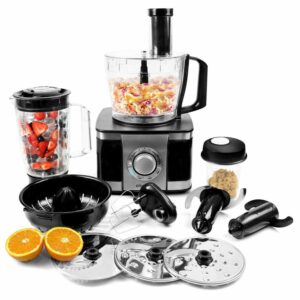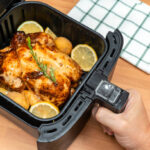It is undebatable that both a food processor and a blender are integral kitchen appliances that assist us in carrying out most culinary tasks. Both of them have many similarities that make many people think they are made to perform similar roles.
For instance, both have a base motor, rotating blades, and a clear body. However, culinary arts professionals have proved that these two kitchen devices differ largely and don’t necessarily substitute each other. Therefore, the user must correctly decide the cases where each of these two devices is used.
Read More: The Four Kitchen Knives You Need for Home Cooking
Though the two kitchen appliances seem equally versatile, a food processor comes with multiple attachments and can perform a wider range of food prep activities. A food processor is the best option for making pie crust. Similarly, it is a powerful tool when it comes to the preparation of baby food. Moreover, it can quickly puree large batches of vegetables and fruits.
On the other hand, a blender usually comes with only one jug and excels in making smoothies from soft and hard ingredients; it is also perfect for making greens smoothies like kale, spinach, and other leafy greens. Also, it can quickly whirl food ingredients to come up with the iciest drinks. So here, we will go into a deeper comparison between the two kitchen essentials.
Disclosure: As an Amazon Associate, we may earn an affiliate commission for purchases you make when using the links on this page.
Table of Contents
Food Processor Functionality

- A quick chopping of vegetables, nuts, or herbs. Its blades spin high speed to turn the food ingredients into suitable sizes. The size of the food items is determined by the time one takes to chop.
- The food processor will easily chop nuts and mix them into the perfect homemade nut butter.
- Furthermore, a food processor is reliable for slicing food items like cucumber, carrots, eggplant, zucchini, and greens. Also, one can slice fruits to make desserts.
- Besides, this kitchen tool is quite efficient for grating food items like carrots, cheese, or potatoes.
- This kitchen appliance is actually a bonus when mixing things like chunky salsa snack bars and pesto.
- With this appliance, you will puree food ingredients like lumpy soups and chickpeas with ease. Above all, most of them have the ability to knead consistent bread dough. Within a span of time, the machine combines the dough components to achieve a sturdy texture.
It is worth noting that there is a mini food processor, which is a compact model for minimal food prep activities.
Food Processor Attachments
Mainly, every food processor comes with s‑blades, grating discs, and slicing discs which do the slicing, mixing, chopping, mincing, and many other activities. Other attachments (whisking disc, dough beater, peeling disc, etc.) make this machine more versatile.
First, an S‑blade, also known as the Sabatier blade, operates in the food processor at the bottom part of the bowl. It is a versatile blade that helps the machine grind, slice, chop, grate veggies and fruits, and churns some food ingredients like nut butter and pesto. Also, this blade is great for mixing to come up with perfect hummus and salsa. Moreover, when it is in a continuous pulse setting, it can turn a particular food item into a puree.
Additionally, a shredding or grating disc is found at the bowl’s top part, and it comes in varying sizes. The disc grates food ingredients like carrots, cheese, and cabbage.
A slicing disc is closely similar to the shredding disc at the bowl’s top part. In particular, this disc will make thin flat strips from apples, potatoes, zucchini, and other food items. Again, to get even and fine slices, ensure that you slowly add the food items.
Apart from the three basic blades (S‑blade, slicing disc, and shredding disc), some food processors come with an additional blade known as a dough blade/kneading paddle. It is less curved than the S‑blade and usually made from plastic. This blade ensures that your food processor has a speed regulator to prevent heat buildup on the dough. Besides, there is a whisk or egg whip blade with two straight arms. This blade enables the food processor to whip creams and egg white. Moreover, many standard food processors have a julienne disc. The user can deploy this disc to make matchsticks from food ingredients.
Pros
- Has a large capacity;
- Quick to chop, slice or grate food;
- Can blend and puree food ingredients;
- Knead dough, grate, chop, and slice food items;
- Protect your family from using sharp items;
Cons
- Requires cleaning and set up, which can be time-consuming;
- Some are expensive to purchase;
- Larger models can take up a lot of countertop space.
Blender Functionality

Generally, blenders are great kitchen appliances for carrying out a wide range of liquidizing and mixing wet food ingredients. These activities include:
- Liquidizing smoothies and milkshakes;
- Additionally, they are perfect for shaving and crushing ice;
- If you need to whip cream, blend the soup or make mayo and sauces, this machine will do it for you;
- Also, you can use the blender to puree baby food and heat liquids;
- With this kitchen device, you can grind coffee and spices, make nut butter, and mill grain flour with ease;
- Above all, high-end blender models have the ability to knead the dough.
Blender Attachments
The Full-size and personal blenders usually have only a jug with inbuilt or removable blades; some may include food processing attachment for light tasks. The jug with the single blade type can carry out a wide range of kitchen tasks such as making smoothies, liquidizing soup, crushing ice, and preparing a variety of sources, dips, and salad dressings.
On the other hand, an immersion blender features several accessories. For instance, an S‑blade will perform a range of tasks similar to full-size and personal blenders. They may have a whisk head that can whip creams or make light cake mixes. They also sometimes include a frothing blade to mix muffins and froth milk. Some immersion blenders come with a masher put in the blade unit to mash boiled potatoes.
Pros
- Great for liquid blends;
- Puree and blend food ingredients with ease;
- Easy to store due to its compatible size;
- Some, like the hand blenders, can mix food in any container;
- Can blend varying quantities of food ingredients;
Cons
- Most of them are noisy while blending;
- They have limited running time;
- Some lack kneads, chop, whisk, and slice options.
Blender vs. Food Processor
Though a blender and a food processor share some similarities, they differ to some extent. Their difference can be based on factors like size, functions, number of accessories, and product quality. For example, a blender works best on wet food ingredients, while a food processor efficiently works on both dry and wet food items. Furthermore, a food processor has the ability to knead a consistent dough, while most blenders lack such a blade option. Hence they are known to have limited versatility when in use.
Furthermore, blenders are the best option when makings smoothies, protein shakes, cocktails, dips, soups, sauces, and crushing ice. On the other hand, a food processor is best for chopping onions, kneading dough, and mincing herbs. In fact, food processors are expensive compared to countertop blenders. It is worth noting that the cost of blenders and food processors may vary from one brand to another. Plus, blenders are known to have a compact size and hence can only occupy a small countertop space. Conversely, food processors can occupy a good kitchen countertop space. If you have to buy a food processor that occupies a smaller counter space, you can go for a mini food chopper.
Additionally, both of these kitchen appliances differ in that blenders can produce varying food textures with better consistency. However, food processors deliver consistent food quality depending on the function. A food processor will do it uniformly, whether you are slicing, dicing, slicing, or kneading.
Summary
In a nutshell, a food processor and a blender have similarities and differences that make them work differently in a kitchen. None of these two can fully replace the other since their features and functions are different. However, each of them is special and functions best in its field. For example, a blender will always do it for you if you are a liquid food enthusiast. Similarly, it is the best option for the preparation of baby food, smoothies, and purees. In cases where you are working on dry food items, a food processor is equal to the task. Mostly a good number of attachments accompany a food processor. These attachments include dough blades, slicers, and graters. Such attachments are a bonus to the usability of this kitchen tool.
Conversely, blenders lack most of these attachments hence making them less versatile. Although both food processors seem to be more versatile than a blender, they are equally important. They are functionally independent, and each of them performs well in its field.



